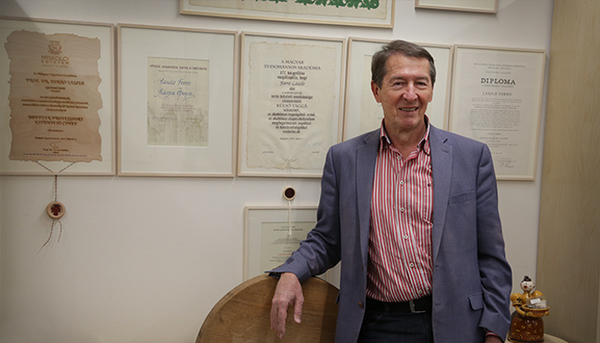László Forró, professor at École Polytechnique Fédérale de Lausanne, Institute of Physics of Condensed Matter in Switzerland, has been named the inaugural director of the new Stavropoulos Center for Complex Quantum Matter at the University of Notre Dame, beginning in the fall of 2021.
Forró will also be the Aurora and Thomas Marquez Professor of Information Theory and Computer Technology in the Department of Physics at Notre Dame. At Lausanne, he is the chair of nanostructures and novel electronic materials, and his research interests include quantum electronic materials, functional nanostructures, and biomaterials. He enjoys analyzing problems and combining all his skills to solve them.
“László will transform physics and materials science at Notre Dame across both the College of Science and the College of Engineering,” said Mary Galvin, formerly the William K. Warren Foundation Dean of the College of Science, who stepped down in December 2020.
Forró said that he was attracted to continuing his career at Notre Dame after discussions with Galvin and Robert Bernhard, vice president of research at Notre Dame. He felt the atmosphere in the physics department was inviting.
“They are also really ambitious,” he said. “They want to create a center for quantum matter which is currently a scientific and technological driver; there’s much funding going into this area.”
Forró has a passion for teaching, communicating about science, and research that spans disciplines, and has published more than 700 papers with over 28,000 citations. Forró also is a member of the Hungarian, Croatian, and Serbian Academies of Sciences.
“Professor Forró is a remarkable scientist and an ideal choice to lead Notre Dame’s quantum matter research efforts," said Marie Lynn Miranda, Charles and Jill Fischer Provost at Notre Dame. "We look forward to welcoming him to campus and pioneering this exciting new research frontier with him. He will be a game-changer for Notre Dame’s reputation in the sciences."

As a professor, Forró has taught general physics for material scientists, micro-technicians and medical students, and for 10 years has taught physics of novel electronic materials to physics students. He urges students to use an analytical approach to problems, comparing the search for information to the medical drama, “House M.D.” (2004-2012), where the main character, Gregory House, uses unconventional thinking and a range of diagnostic techniques to solve medical mysteries. “Students—and researchers—should use their entire range of techniques and analytical skills to solve problems in much the same way,” Forró said.
In the laboratory, the same principle applies. Fundamental research is important in physics because it’s a practical science, and Forró believes it should be approached in a way that it will lead to real applications.
“Our research should serve for something,” he said. “We want to understand what the basic principles are of what we are seeing, and once we are getting closer, the next question is: What is this good for?”
For example, one of his long-term areas of research has been in developing nanostructures from titanium dioxide. Titanium dioxide is a mineral in many everyday items, including paint and toothpaste. But when one makes nanowires of them, they could be bound together in a “tissue” or a filter paper, which could be used for sterilization in various environments. This is because titanium dioxide is an excellent photo catalyst, and when illuminated in a liquid environment it creates free radicals—molecules that interact with living matter and can destroy germs.
“For example, we can apply this tissue for water purification, where viruses and bacteria can be killed when exposed to light,” he said. The purification system would not have to use electricity, which would make it useful in many developing countries.
The tissue could also be applied to reusable masks, he said. “You can put the mask in a case and close it, with a small UV light that switches on for three minutes, and it sanitizes your mask. You don’t have to throw the mask away and contaminate the environment.”
Starting from a basic concept to this type of practical application is what Forró is most looking forward to accomplishing at Notre Dame.
“This will be very challenging and very exciting,” he said.
Originally published by at science.nd.edu on May 10, 2021.